
VF-74
Encyclopedia
VF-74, Fighter Squadron 74, Be-Devilers was an aviation unit of the United States Navy
in service from 1944 to 1994.
VF-74 was established on 16 April 1945 as VBF-20 flying the F4U-1 Corsair
from NAS Wildwood in New Jersey
. After six months they transitioned to the F6F Hellcat
but soon changed to F8F Bearcats. During World War II the squadron flew from the and participated in the invasion of southern France (Operation Dragoon
) as part of Task Force 88
. In 15 November 1946 their designation was changed to VF-10A and was part of Carrier Air Group 9 on board and made their first deployment to the Mediterranean between February and June 1948. Before the cruise VF-10A had shifted to their new shore base of Naval Auxiliary Air Station Charlestown
, Rhode Island
. At the same time, the squadron had adopted their devil’s insignia created by Ensign
John P. Humphries. On 12 August 1948 the squadron became VF-92 and became part of CAG-7, moving to Naval Air Station Quonset Point
and their final re-designation happened on 15 January 1950 when they became VF-74. They transitioned to the F4U-4 Corsair in 1951 and returned to the Mediterranean on board the .
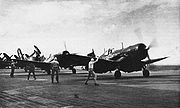 With the Korean war
With the Korean war
raging, CAG-7 transferred to the Pacific in May 1952 and conducted a combat cruise on board the . They were in combat for six months and flew 1500 combat sorties, mainly against North Korea
n targets. They also moved to the F9F-8 Cougar
, their first jet aircraft.
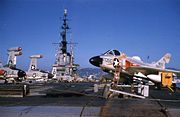 Within 12 months the Banshee was replaced by the F4D-1 Skyray
Within 12 months the Banshee was replaced by the F4D-1 Skyray
which was the US Navy’s first supersonic fighter, although it was phased out in 1962. VF-74 deployed to the Mediterranean three times, twice on board the and their final deployment was on USS Franklin D. Roosevelt.
On 8 July 1961 VF-74 began to transition to the F-4B Phantom II becoming the first deployable F-4 squadron, giving rise to their "First in Phantoms" motto. They deployed aboard in August 1962{fact}. For 20 years VF-74 would deploy 15 times with the Phantom, 13 to the Mediterranean and two to South East Asia. Their first Vietnam
cruise aboard was marked by tragedy on 29 July 1967, when an ordnance explosion on the flight deck
caused a massive ensuing fire
. VF-74 lost 42 enlisted personnel and three F-4s. Many squadron members were commended for their heroic actions whilst fighting the fires.
In early 1972 they transitioned from the F-4B to the F-4J. Between July 1972 to February 1973 the squadron returned to combat in Vietnam on board the . During seven periods on the famous Yankee Station
VF-74 did not lose a single aircraft to enemy action. VF-74 was just as successful in peace time, winning the CNO Safety “S” in 1974 along with the Battle "E". In 1975, they moved to CVW-8 and took part in the maiden cruise of . In 1976 they won the Admiral Joseph Clifton Award, making them the top US Navy fighter squadron.
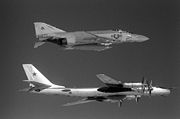 In 1982 they transitioned from the F-4J to the F-4S and made their final cruise with the F-4 Phantom from May{date} to 16 November 1982. In February 1983 they began the transition to the F-14 Tomcat
In 1982 they transitioned from the F-4J to the F-4S and made their final cruise with the F-4 Phantom from May{date} to 16 November 1982. In February 1983 they began the transition to the F-14 Tomcat
and in October the same year the squadron reported back to CVW-17 and their first cruise was in April 1984 on board the USS Saratoga which ended in October the same year.
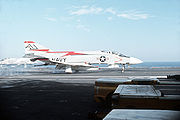 In 1985 VF-74 and VF-103 became famous in the fight against terrorism. On 7 October member of the PLF
In 1985 VF-74 and VF-103 became famous in the fight against terrorism. On 7 October member of the PLF
hijacked the Italian
cruise liner Achille Lauro
. When the ship arrived in Syria
the hijackers made their way to Egypt
where they were promised free passage to Tunisia
in return of the hostages lives. The terrorists boarded an Egypt Air Boeing 737
on the night of 10 October. But thanks to US Intelligence, president Ronald Reagan
, ordered the Sixth Fleet to take action, to force down the 737 to Sigonella where US Special Forces could capture the hijackers. Four F-14s and an E-2C Hawkeye launched from Saratoga. The plan called for Saratoga's planes to make night intercepts and identifications of air contacts on the airways crisscrossing the central Mediterranean as they flew eastward toward a comman airway intersection south of Crete. After four interceptions, following two hair-raising, lights out intercepts of planes, the F-14s found the right aircraft. At about 2230, 30 miles (48.3 km) southeast of Crete they closed in on the 737 which showed the tail number 2843 which identified the aircraft as the one they were looking for. After identifying themselves to the airliner’s pilot, the American planes eventually were able to convince the 737 to land at the NATO base in Sigonella, Sicily
. Upon landing, the airliner was quickly surrounded by American soldiers. The terrorists ultimately were taken into Italian custody.
1986 was another busy year for VF-74 as they took part in Operation Attain Document
and Operation El Dorado Canyon
. During the next few years, VF-74 would make regular deployments to the Mediterranean Sea as part of CVW-17.
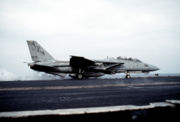 On 11 August 1988 VF-74 became the first squadron to receive the F-14A+ (now F-14B). By the end of the year they had finished the transition and VF-74 became the first squadron to launch an AIM-54 Phoenix
On 11 August 1988 VF-74 became the first squadron to receive the F-14A+ (now F-14B). By the end of the year they had finished the transition and VF-74 became the first squadron to launch an AIM-54 Phoenix
from an F-14A+.
In 1990, VF-74 took part in Operation Desert Shield and Operation Desert Storm. VF-74 relieved the , they took up station in the Red Sea
and worked with the . After eight months they returned to NAS Oceana on 29 March 1991. Within a year, VF-74 was back on cruise with the USS Saratoga on 6 May 1992. Operations included taking part in support of the United Nations aid to the former republics of Yugoslavia
in July. On 14 September, VF-74 flew 1.7 nautical miles (3.1 km), dropping ordnance on the Wadi Natrun target range in Egypt
. The squadron returned home on 6 November.
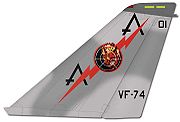 As usual after returning from cruise, the squadron went straight to workups for the next deployment on board the after the carrier had returned from Service Life Extension Program, they also conducted carrier qualifications on USS Saratoga. However, in August 1993 the Navy decided to deploy only one F-14 squadron on board Saratoga, and as VF-74 was a non-TARPS squadron they were left back home and moved from CVW-17 to be under direct command of Fighter Wing Atlantic. Although they did not take part in any cruise VF-74 took up aggressor role with various Navy and Air Force squadrons. On 20 January 1994, VF-74 took part in the last deployment, this time to Roosevelt Roads Naval Station
As usual after returning from cruise, the squadron went straight to workups for the next deployment on board the after the carrier had returned from Service Life Extension Program, they also conducted carrier qualifications on USS Saratoga. However, in August 1993 the Navy decided to deploy only one F-14 squadron on board Saratoga, and as VF-74 was a non-TARPS squadron they were left back home and moved from CVW-17 to be under direct command of Fighter Wing Atlantic. Although they did not take part in any cruise VF-74 took up aggressor role with various Navy and Air Force squadrons. On 20 January 1994, VF-74 took part in the last deployment, this time to Roosevelt Roads Naval Station
in February where VF-74 launched seven air-to-air missiles with 100% success rate. On 30 April 1994, VF-74 was disestablished after 50 years of service.
United States Navy
The United States Navy is the naval warfare service branch of the United States Armed Forces and one of the seven uniformed services of the United States. The U.S. Navy is the largest in the world; its battle fleet tonnage is greater than that of the next 13 largest navies combined. The U.S...
in service from 1944 to 1994.
History
- Source: Tomcat
VF-74 was established on 16 April 1945 as VBF-20 flying the F4U-1 Corsair
F4U Corsair
The Vought F4U Corsair was a carrier-capable fighter aircraft that saw service primarily in World War II and the Korean War. Demand for the aircraft soon overwhelmed Vought's manufacturing capability, resulting in production by Goodyear and Brewster: Goodyear-built Corsairs were designated FG and...
from NAS Wildwood in New Jersey
New Jersey
New Jersey is a state in the Northeastern and Middle Atlantic regions of the United States. , its population was 8,791,894. It is bordered on the north and east by the state of New York, on the southeast and south by the Atlantic Ocean, on the west by Pennsylvania and on the southwest by Delaware...
. After six months they transitioned to the F6F Hellcat
F6F Hellcat
The Grumman F6F Hellcat was a carrier-based fighter aircraft developed to replace the earlier F4F Wildcat in United States Navy service. Although the F6F resembled the Wildcat, it was a completely new design powered by a 2,000 hp Pratt & Whitney R-2800. Some tagged it as the "Wildcat's big...
but soon changed to F8F Bearcats. During World War II the squadron flew from the and participated in the invasion of southern France (Operation Dragoon
Operation Dragoon
Operation Dragoon was the Allied invasion of southern France on August 15, 1944, during World War II. The invasion was initiated via a parachute drop by the 1st Airborne Task Force, followed by an amphibious assault by elements of the U.S. Seventh Army, followed a day later by a force made up...
) as part of Task Force 88
Task Force 88 (Operation Dragoon)
Task Force 88 was the escort carrier force, commanded by Rear-Admiral T H Troubridge, that supported Operation Dragoon, the allied invasion of southern France. It was activated in August 1944, and dispersed on 29 August when the carrier force departed to operate in the Aegean.The TF88 was a mixed...
. In 15 November 1946 their designation was changed to VF-10A and was part of Carrier Air Group 9 on board and made their first deployment to the Mediterranean between February and June 1948. Before the cruise VF-10A had shifted to their new shore base of Naval Auxiliary Air Station Charlestown
Naval Auxiliary Air Station Charlestown
Charlestown Naval Auxiliary Air Station is located in Charlestown, Rhode Island. It was a satellite airfield to the nearby Quonset Naval Air Station. It is located within the boundaries of the Ninigret National Wildlife Refuge.- History :...
, Rhode Island
Rhode Island
The state of Rhode Island and Providence Plantations, more commonly referred to as Rhode Island , is a state in the New England region of the United States. It is the smallest U.S. state by area...
. At the same time, the squadron had adopted their devil’s insignia created by Ensign
Ensign (rank)
Ensign is a junior rank of a commissioned officer in the armed forces of some countries, normally in the infantry or navy. As the junior officer in an infantry regiment was traditionally the carrier of the ensign flag, the rank itself acquired the name....
John P. Humphries. On 12 August 1948 the squadron became VF-92 and became part of CAG-7, moving to Naval Air Station Quonset Point
Naval Air Station Quonset Point
Naval Air Station Quonset Point was a United States Naval Base in Quonset Point, Rhode Island that was deactivated in 1974. Next to NAS Quonset Point was Camp Endicott at Davisville, home of the Naval Construction Battalions known as the Seabees. Quonset Point also gave its name to the Quonset hut,...
and their final re-designation happened on 15 January 1950 when they became VF-74. They transitioned to the F4U-4 Corsair in 1951 and returned to the Mediterranean on board the .

Korean War
The Korean War was a conventional war between South Korea, supported by the United Nations, and North Korea, supported by the People's Republic of China , with military material aid from the Soviet Union...
raging, CAG-7 transferred to the Pacific in May 1952 and conducted a combat cruise on board the . They were in combat for six months and flew 1500 combat sorties, mainly against North Korea
North Korea
The Democratic People’s Republic of Korea , , is a country in East Asia, occupying the northern half of the Korean Peninsula. Its capital and largest city is Pyongyang. The Korean Demilitarized Zone serves as the buffer zone between North Korea and South Korea...
n targets. They also moved to the F9F-8 Cougar
F9F Cougar
The Grumman F9F/F-9 Cougar was an aircraft carrier-based fighter aircraft for the United States Navy. Based on the earlier Grumman F9F Panther, the Cougar replaced the Panther's straight wing with a more modern swept wing...
, their first jet aircraft.

F4D Skyray
The Douglas F4D Skyray was an American carrier-based supersonic fighter/interceptor built by the Douglas Aircraft Company...
which was the US Navy’s first supersonic fighter, although it was phased out in 1962. VF-74 deployed to the Mediterranean three times, twice on board the and their final deployment was on USS Franklin D. Roosevelt.
On 8 July 1961 VF-74 began to transition to the F-4B Phantom II becoming the first deployable F-4 squadron, giving rise to their "First in Phantoms" motto. They deployed aboard in August 1962{fact}. For 20 years VF-74 would deploy 15 times with the Phantom, 13 to the Mediterranean and two to South East Asia. Their first Vietnam
Vietnam
Vietnam – sometimes spelled Viet Nam , officially the Socialist Republic of Vietnam – is the easternmost country on the Indochina Peninsula in Southeast Asia. It is bordered by China to the north, Laos to the northwest, Cambodia to the southwest, and the South China Sea –...
cruise aboard was marked by tragedy on 29 July 1967, when an ordnance explosion on the flight deck
Flight deck
The flight deck of an aircraft carrier is the surface from which its aircraft take off and land, essentially a miniature airfield at sea. On smaller naval ships which do not have aviation as a primary mission, the landing area for helicopters and other VTOL aircraft is also referred to as the...
caused a massive ensuing fire
1967 USS Forrestal fire
The 1967 USS Forrestal fire was a devastating fire and series of chain-reaction explosions on 29 July 1967 that killed 134 sailors and injured 161 on the aircraft carrier , after an unusual electrical anomaly discharged a Zuni rocket on the flight deck...
. VF-74 lost 42 enlisted personnel and three F-4s. Many squadron members were commended for their heroic actions whilst fighting the fires.
In early 1972 they transitioned from the F-4B to the F-4J. Between July 1972 to February 1973 the squadron returned to combat in Vietnam on board the . During seven periods on the famous Yankee Station
Yankee Station
Yankee Station was a point in the Gulf of Tonkin off the coast of Vietnam used by the U.S. Navy aircraft carriers of Task Force 77 to launch strikes in the Vietnam War. While its official designation was "Point Yankee," it was universally referred to as Yankee Station...
VF-74 did not lose a single aircraft to enemy action. VF-74 was just as successful in peace time, winning the CNO Safety “S” in 1974 along with the Battle "E". In 1975, they moved to CVW-8 and took part in the maiden cruise of . In 1976 they won the Admiral Joseph Clifton Award, making them the top US Navy fighter squadron.

F-14 Tomcat
The Grumman F-14 Tomcat is a supersonic, twin-engine, two-seat, variable-sweep wing fighter aircraft. The Tomcat was developed for the United States Navy's Naval Fighter Experimental program following the collapse of the F-111B project...
and in October the same year the squadron reported back to CVW-17 and their first cruise was in April 1984 on board the USS Saratoga which ended in October the same year.

PLF
PLF may stand for:* Palestine Liberation Front* Parachute Landing Fall* Passenger load factor* Payload launch fairing, to reduce atmospheric drag and protect a rocket payload until space is reached* Penguin Liberation Front...
hijacked the Italian
Italy
Italy , officially the Italian Republic languages]] under the European Charter for Regional or Minority Languages. In each of these, Italy's official name is as follows:;;;;;;;;), is a unitary parliamentary republic in South-Central Europe. To the north it borders France, Switzerland, Austria and...
cruise liner Achille Lauro
MS Achille Lauro
MS Achille Lauro was a cruise ship based in Naples, Italy. Built between 1939 and 1947 as MS Willem Ruys, a passenger liner for the Rotterdamsche Lloyd. It is most remembered for its 1985 hijacking...
. When the ship arrived in Syria
Syria
Syria , officially the Syrian Arab Republic , is a country in Western Asia, bordering Lebanon and the Mediterranean Sea to the West, Turkey to the north, Iraq to the east, Jordan to the south, and Israel to the southwest....
the hijackers made their way to Egypt
Egypt
Egypt , officially the Arab Republic of Egypt, Arabic: , is a country mainly in North Africa, with the Sinai Peninsula forming a land bridge in Southwest Asia. Egypt is thus a transcontinental country, and a major power in Africa, the Mediterranean Basin, the Middle East and the Muslim world...
where they were promised free passage to Tunisia
Tunisia
Tunisia , officially the Tunisian RepublicThe long name of Tunisia in other languages used in the country is: , is the northernmost country in Africa. It is a Maghreb country and is bordered by Algeria to the west, Libya to the southeast, and the Mediterranean Sea to the north and east. Its area...
in return of the hostages lives. The terrorists boarded an Egypt Air Boeing 737
Boeing 737
The Boeing 737 is a short- to medium-range, twin-engine narrow-body jet airliner. Originally developed as a shorter, lower-cost twin-engine airliner derived from Boeing's 707 and 727, the 737 has developed into a family of nine passenger models with a capacity of 85 to 215 passengers...
on the night of 10 October. But thanks to US Intelligence, president Ronald Reagan
Ronald Reagan
Ronald Wilson Reagan was the 40th President of the United States , the 33rd Governor of California and, prior to that, a radio, film and television actor....
, ordered the Sixth Fleet to take action, to force down the 737 to Sigonella where US Special Forces could capture the hijackers. Four F-14s and an E-2C Hawkeye launched from Saratoga. The plan called for Saratoga's planes to make night intercepts and identifications of air contacts on the airways crisscrossing the central Mediterranean as they flew eastward toward a comman airway intersection south of Crete. After four interceptions, following two hair-raising, lights out intercepts of planes, the F-14s found the right aircraft. At about 2230, 30 miles (48.3 km) southeast of Crete they closed in on the 737 which showed the tail number 2843 which identified the aircraft as the one they were looking for. After identifying themselves to the airliner’s pilot, the American planes eventually were able to convince the 737 to land at the NATO base in Sigonella, Sicily
Sicily
Sicily is a region of Italy, and is the largest island in the Mediterranean Sea. Along with the surrounding minor islands, it constitutes an autonomous region of Italy, the Regione Autonoma Siciliana Sicily has a rich and unique culture, especially with regard to the arts, music, literature,...
. Upon landing, the airliner was quickly surrounded by American soldiers. The terrorists ultimately were taken into Italian custody.
1986 was another busy year for VF-74 as they took part in Operation Attain Document
Action in the Gulf of Sidra (1986)
In the Action in the Gulf of Sidra, the United States Navy deployed aircraft carrier groups in the disputed Gulf of Sidra in the Mediterranean Sea. Libya claimed that the entire Gulf was their territory, at 32° 30' N, with an exclusive fishing zone. Libyan leader Muammar al-Gaddafi asserted this...
and Operation El Dorado Canyon
Operation El Dorado Canyon
The 1986 United States bombing of Libya, code-named Operation El Dorado Canyon, comprised the joint United States Air Force, Navy and Marine Corps air-strikes against Libya on April 15, 1986. The attack was carried out in response to the 1986 Berlin discotheque bombing.-Origins:Shortly after his...
. During the next few years, VF-74 would make regular deployments to the Mediterranean Sea as part of CVW-17.

AIM-54 Phoenix
The AIM-54 Phoenix is a radar-guided, long-range air-to-air missile , carried in clusters of up to six missiles on F-14 Tomcats, its only launch platform. The Phoenix was the United States' only long-range air-to-air missile. The weapons system based on Phoenix was the world's first to allow...
from an F-14A+.
In 1990, VF-74 took part in Operation Desert Shield and Operation Desert Storm. VF-74 relieved the , they took up station in the Red Sea
Red Sea
The Red Sea is a seawater inlet of the Indian Ocean, lying between Africa and Asia. The connection to the ocean is in the south through the Bab el Mandeb strait and the Gulf of Aden. In the north, there is the Sinai Peninsula, the Gulf of Aqaba, and the Gulf of Suez...
and worked with the . After eight months they returned to NAS Oceana on 29 March 1991. Within a year, VF-74 was back on cruise with the USS Saratoga on 6 May 1992. Operations included taking part in support of the United Nations aid to the former republics of Yugoslavia
Yugoslavia
Yugoslavia refers to three political entities that existed successively on the western part of the Balkans during most of the 20th century....
in July. On 14 September, VF-74 flew 1.7 nautical miles (3.1 km), dropping ordnance on the Wadi Natrun target range in Egypt
Egypt
Egypt , officially the Arab Republic of Egypt, Arabic: , is a country mainly in North Africa, with the Sinai Peninsula forming a land bridge in Southwest Asia. Egypt is thus a transcontinental country, and a major power in Africa, the Mediterranean Basin, the Middle East and the Muslim world...
. The squadron returned home on 6 November.

Roosevelt Roads Naval Station
Roosevelt Roads Naval Station is a former United States military air base in the town of Ceiba, Puerto Rico. The site is run today as José Aponte de la Torre Airport, a public use airport.-History:...
in February where VF-74 launched seven air-to-air missiles with 100% success rate. On 30 April 1994, VF-74 was disestablished after 50 years of service.
See also
- History of the United States NavyHistory of the United States NavyThe history of the United States Navy divides into two major periods: the "Old Navy", a small but respected force of sailing ships that was also notable for innovation in the use of ironclads during the American Civil War, and the "New Navy", the result of a modernization effort that began in the...
- List of inactive United States Navy aircraft squadrons
- List of United States Navy aircraft squadrons

